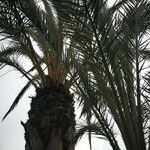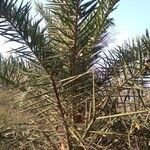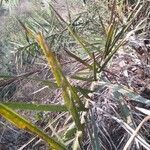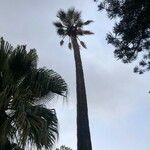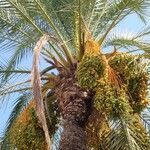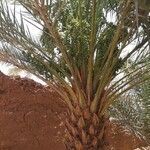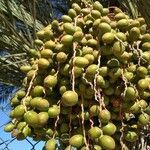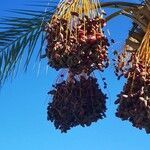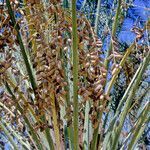A tall unbranched evergreen palm. It grows to 30 m high. The trunk can be 30-40 cm across. The trunk is covered with fibres and has the bases of old leaves along it. It produces suckers on the trunk and at the base. The fronds are grey-green. The leaves are 6-7 m long. The leaflets are 20-40 cm long. They are spaced in two irregular rows along each side of the stalk. Male and female flowers are produced on separate trees. The flowers spadices are yellow-brown. There are 1,000-1,500 fruit is a cluster. The fruit is small, brown and very sweet. It has one grooved seed. The fruit is 2.5-5 cm long. When ripe the fruit is dull yellow and the flesh soft. The skins of the fruit darken when dried. Strands of fruit have 25-35 dates. The fruit are edible.
Clustering, or infrequently solitary palms to 30 m tall; trunk 35–50 cm diam. Leaves 30–50, 2.5–7 m long; acanthophylls to 15 cm long. Pinnae c. 50–130 each side of rachis, regularly arranged in 1 plane, to 65 cm long, to 2 cm wide, dull glaucous green on both surfaces. Staminate inflorescence 30–60 cm long; prophyll to 45 cm long, brown-tomentose; flowers white to cream, in groups or scattered, 10–15 mm long, to 3 mm wide. Pistillate inflorescence to 120 cm long, similar to staminate but with elongate peduncle; flowers white to yellow, to 5 mm diam. Fruit ovoid to oblong, 40–70 mm long, 20–30 mm diam., yellow, orange brown, chestnut to black; mesocarp thick and sugary. Seed to 24 mm long, to 8 mm wide.
Stems solitary or clustered and then with few shoots, to 30 m tall, to 50 cm in diam., rough with persistent, diamond-shaped leaf bases. Leaves 3-5 m; sheath and petiole to 1 m; rachis 1-2 m; acanthophylls many per side of rachis; pinnae to 200 per side of rachis, linear, irregularly arranged and spreading in different planes; middle pinnae to 40 × 2 cm. Male inflorescences erect, to 1 m, with many rachillae, these ca. 30 cm; female inflorescences erect, becoming pendulous, to 2 m, with to 150 rachillae, these to 40 cm. Fruits variable in shape, usually oblong, to 7 × 3 cm, brown or black; endosperm homogeneous.
Characteristic tall, straight trunk, clothed rather persistent leaf-bases, and head of stiff fronds
